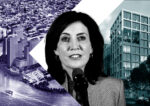Trending
In final State of the City address, Bloomberg vows to push ahead with megaprojects

Mayor Michael Bloomberg, in his final State of the City address, applauded the role that real estate developers have had in shaping what he referred to as “the big city of big dreams,” and pointed out that megaprojects such as Hudson Yards, One World Trade Center and the redevelopment of the South Street Seaport would revitalize the economy and ensure that New York will remain a major player on the world stage.
Speaking at the Barclays Center on his 70th birthday, Bloomberg began his address with a tribute to recently-deceased Mayor Ed Koch and credited him with restoring “the arc of our city’s history.”
Bloomberg also acknowledged the unlikely presence of the Barclays Center, saying that “here we are, despite all the odds, despite all the challenges, the naysayers and the NIMBYers.” He asked the crowd to acknowledge the project’s developer, Forest City Ratner’s Bruce Ratner, who was in the audience, and Brooklyn President Marty Markowitz, who minutes earlier had effusively introduced the mayor. “Not long ago, this arena was nothing more than a glimmer in Marty Markowitz’s eye.” As Bloomberg prepares to leave office at the end of this year, many real estate industry observers remain hopeful that he can push through some key proposals, such as the rezoning of Midtown East, before his term is up. Today’s speech offered something of a tonic for industry insiders worried that his replacement will be less development-friendly.
“Our goal is not to spend the year cutting ribbons,” Bloomberg said. “Our goal is to advance projects and start new ones.” He then proceeded to rattle off a dizzying array of new and ongoing major development projects, including: New York City Water Tunnel No. 3, the largest construction project in the city’s history, which he called “a dramatic statement of funding vital infrastructure projects”; the 2,200-acre Freshkills Park in Staten Island, the largest park since the 1930s; the Port Authority and Durst Organization’s One World Trade Center; the renovation of the New York Public Library, which will be the largest circulation and research library in the world; expansions of Columbia University, New York University and Fordham University; Two Trees Management’s Domino Sugar Factory redevelopment, which Bloomberg said would “create the commercial space that Brooklyn’s growing tech community needs”; and Cornell University’s new science and engineering campus on Roosevelt Island, which he called “perhaps the most exciting economic development project.”
“Is there anyone here who still believes New York City can’t get things done?” the mayor asked, in a rare display of humor. “Since we’re in Brooklyn I’ll say it: fuggedaboutit.”
Bloomberg also pointed out that projects in what he termed long-neglected areas would stimulate the economy through job creation.
Of Governor’s Island, he said that after being “closed to the public for two centuries, it has become one of the most popular gateways in the city,” and added that the city had invited businesses and nonprofits to establish a year-round presence there and help preserve its historic buildings. He spoke about the “spectacular” new Brooklyn Bridge Park, and also lauded Coney Island’s “comeback,” as well as Staten Island’s jumbo Ferris wheel in St.George. He praised the development of the High Line, which a few years ago was headed for demolition.Of Willets Point, Bloomberg expressed hopes of a future convention center in an area he said was “ignored since Robert Moses failed to bring a park to it.”
“Yes, you can applaud,” he added, and the audience indulged him.
Bloomberg also recognized the rezoning that had allowed for the transformation of DUMBO, Greenpoint and Long Island City, and added that the proposed rezoning of Midtown East would help the area reclaim the title of the world’s leading business hub. The new buildings that would rise as a result of the rezoning would pay into a mass transit fund that would help maintain the area’s transportation services.
Bloomberg showed the audience renderings of Related’s much-discussed Culture Shed, an arts and culture center at the upcoming Hudson Yards, which he said would be a “magnet for artists and audiences.”
The mayor was lavish in his praise of the city’s response to Hurricane Sandy, pointing out that the houses that took the brunt of the damage were decades old, and newer developments had better weathered the storm.
Still, he was adamant that much more needed to be done, and announced that Seth Pinsky, the president of the New York City Economic Development Corporation, would submit a report in May detailing how the city could beef up its resilience to extreme weather.
“Sandy made it clear how much NYCHA’s housing stock is suffering from federal negligence,” he added, noting that his administration would seek revenues to fund repairs
and capital investments at the housing projects, likely referring to the public housing authority’s proposal to net about $50 million annually through leases to private developers for high-rise projects.
But even in Sandy’s wake, Bloomberg stressed that it was necessary to embrace waterfront development. “We are a coastal city. We cannot and will not abandon the waterfront. That was the mistake that Robert Moses made, and we have been working for decades to undo. We will build stronger, more sustainably, but we will build back here.”




